Dr.Teruo Higa’s
Living A Dream
- 2025
- Sep:#209 The Widespread Use of EM in Ecuador
- Sep:#208 The Widespread Use of EM in Chile
- Jul:#207 Peru, where EM has taken root throughout the country
- May:#206 EM Application Technology in Paraguay Begins to Evolve into Advanced Circular Agriculture
- May:#205 Practical Application of Soil Disinfectant-Free Cultivation Using EM Technology
- Apr:#204 How EM Use Has Spread Throughout the Philippines
- Mar:#203 How to Use EM to Fundamentally Solve the Problem of Agricultural Residue Burning
- Feb:#202 The Spread of EM technology in Germany
- Jan:#201 The 2nd Ichiro Masaki Memorial Universal Village EM International Conference
- Jan:#200 Cleanup of the Ala Wai Canal in Hawaii, where social bonds are strengthened using EM
- 2024
- Nov:#199 EM trials in India with bananas, tomatoes, and pomegranates
- Oct:#198 The Steadily Evolving EM Nature Farming Method at the Blue Sky Palace - Part 8
- Sep:#197 The Steadily Evolving EM Nature Farming Method at the Blue Sky Palace - Part 7
- Aug:#196 The Steadily Evolving EM Nature Farming Method at the Blue Sky Palace - Part 6
- Jul:#195 The Steadily Evolving EM Nature Farming Method at the Blue Sky Palace - Part 5
- Jun:#194 Steadily Evolving EM Nature Farming Method at the Blue Sky Palace - Part 4
- May:#193 Steadily Evolving EM Nature Farming Method at the Blue Sky Palace - Part 3
- May:#192 Steadily Evolving EM Nature Farming Method at the Blue Sky Palace - Part 2
- Apr:#191 Steadily Evolving EM Nature Farming Method at the Blue Sky Palace
- Mar:#190 Quantum Mechanical Effects of EM Gravitron Charcoal
- Mar:#189 The barrier space in Okinawa (Ryukyu Islands) has risen to another dimension
- Jan:#188 Sixty Days after Typhoon No.6
- 2023
- Oct:#187 Supermassive Typhoon No.6 and Subsequent Typhoon No. 11
- Sep:#186 Massive Typhoon No.6 that swallowed the Ryukyu Islands Graviton barrier
- Sep:#185 August 8th is World “EM Mudball Day”
- Aug:#184 A disease-free life depends on the health of the intestinal microbiome.
- Jul:#183 Trial and Error at the Blue-Sky Palace, Part 3
- Jun:#182 Trial and Error at the Blue-Sky Palace, Part 2
- Apr:#181 Trial and Error at the Blue-Sky Palace
- Mar:#180 Ala Wai Canal Cleanup Project in Waikiki, Hawaii
- Feb:#179 High-Yield, High-Quality Rice Production Using EM
- Feb:#178 The Progress the "Soil Preparation Workshop" of the Oishi 3-chan Club (Part 2)
- Jan:#177 Organic Farming Instructional Manual Using EM
- 2022
- Nov:#176 The Typhoon Situation in Okinawa in 2022
- Sep:#175 Third-Party Verification of the Graviton barrier in Okinawa Part-2
- Sep:#174 Third-Party Verification of the Graviton barrier in Okinawa
- Aug:#173 Ecosystem Changes Observed in Okinawa in 2021 Part-5
- Jun:#172 Ecosystem Changes Observed in Okinawa in 2021 Part-4
- May:#171 Ecosystem Changes Observed in Okinawa in 2021 Part-3
- Apr:#170 Ecosystem Changes Observed in Okinawa in 2021 Part-2
- Mar:#169 Koizumi Farm in Kamakura Continues to Evolve
- Feb:#168 Ecosystem Changes Observed in Okinawa in 2021 Part-1
- 2021
- Dec:#167 Enjoying EM Technology While Enriching the Local Ecosystem
- Nov:#166 A Case Study of the Use of EM in a Next Generation Free School in Tune with the Cycles of Nature
- Oct:#165 Typhoon conditions and flowers in Okinawa from August to October
- Sep:#164 Re-learning the origins of river purification using EM Cleaning up the Dairyuji River in Senami (Murakami City, Niigata Prefecture)
- Aug:#163 Measures Against Natural Disasters and Re-learning the Starting Point of EM
- Jul:#162 Summary of FFC (Foods for Children) Okinawa Forum 2021
- Jun:#161 Restoring the Vigor of an Old Tree and Purifying the Environment with EM Technology That Even an Amateur Can Do
- May:#160 The Public is Beginning to Recognize the Use of EM Smokeless Carbonizers
- Apr:#159 EM Hado (EM Graviton) that exerts quantum superposition effect over time
- Mar:#158 Virus-free Okinawan Plants Through Use of an EM Graviton Barrier
- Jan:#157 Enjoyable Farming for Self-Sufficiency that Even Amateurs Can Do
- 2020
- Dec:#156 EM quantum energy effect occurring in Okinawa
- Nov:#155 Implementing EM graviton farming as a flood countermeasure for apple orchards
- Oct:#154 The Latest Book on the Practical Uses of EM "You Are the One Who Draws Out the Power of Microorganisms," by Chizuko Nomoto
- Sep:#153 Application of EM technology to long periods of rain, lack of sunshine, storms, heavy rains, etc.
- Aug:#152 EM application in Kitanakagusuku village plant waste recycling yard
- Jul:#151 Natural Disaster Countermeasures Using EM Technology: Part 2
- Jul:#150 Natural Disaster Countermeasures Using EM Technology
- May:#149 How to make your home and workplace an energy spot by living a complete EM lifestyle: creating the ultimate source of health and environmental purification
- Apr:#148 EM, Viruses and the Pandemic
- Apr:#147 New agriculture applying quantum mechanics Part 2
- Apr:#146 New agriculture applying quantum mechanics
- Apr:#145 Wonderful EM Miracle
- 2019
- Nov:#144 The movie “Revival II” and the reality of Fukushima
- Oct:#143 Boundary dome and foliar spraying of EM・X GOLD and EM 3
- Oct:#142 Kirakira (Sparkling) Summer Vegetable Festa in 2019
- Aug:#141 Excessive salt inevitably causes salt damage
- Jul:#140 Diverse applications of charcoal Part 3
- Jun:#139 Diverse applications of charcoal Part 2
- Jun:#138 Diverse applications of charcoal
- Jun:#137 Purification power of salt
- May:#136 The degree of soil contamination is a reflection of the microflora
- May:#135 Definitive use of EM barriers to deal with typhoons
- May:#134 Implementing authentic Nature Farming
- May:#133 How to enhance healthy Hado (wave energy) by EM
- May:#132 Eating Dirt (Soil)
- May:#131 Hado (Wave energy) involved in health
- May:#130 Reaffirming EM technology to realize the essence of agriculture
- May:#129 The 2nd EM Producer Networking Meeting
- Apr:#128 Understanding the application of seawater and salt in crop cultivation
- Apr:#127 Prevention of Disasters by EM Technology
- Mar:#126 Quantum overlay effective utilization of EM
- Jan:#125 EM Disaster Recovery Support Projects in 2017
- 2018
- 2017
- Aug:#121 Escape from conventional agricultural traps
- Jul:#120 Limitation and important caveats regarding utilization of salt
- Jun:#119 EM Technology to Break Through the Limits of Pesticide-Free Strawberries
- May:#118 Application of barriers using EM rectification force
- Apr:#117 The 1st EM Produce Growers' Networking Conference
- Mar:#116 Sumizo kun: The Ultimate Versatile Carbonization Equipment
- Feb:#115 How to make and use simple carbonized and rectified ash
- Jan:#114 Achievements of 2016
- 2016
- Dec:#113 Definitive Measures Against Typhoons
- Nov:#112 International Conference on Universal Village
- Oct:#111 90% of Your Body is Microbes
- Sep:#110 Disaster Countermeasures Using EM
- Aug:#109: Changes in the Natural Environment by EM Barrier Domes in Okinawa
- Jul:#108: Multi-purpose Utilization of Activated EM with Seawater and Salt
- Jun:#107: Marine Day, when EM Mudballs and Activated EM are Applied Throughout Japan
- May:#106: The Function of EM and Gravitational Waves–Part 3
- Apr:#105: The Function of EM and Gravitational Waves–Part 2
- Feb:#104: The Function of EM and Gravitational Waves
- Feb:#103: The Importance of Phototrophic Bacteria in EM
- 2015
- Dec:#102: Results of Environmental Forum "Utsukushima EM Paradise" 2015
- Nov:#101: Environmental Forum "Utsukushima EM Paradise" 2015
- Oct:#100: A New Phase of Limit Breakthrough Using EM
- Sep:#99: A New Phase of Limit Breakthrough through EM
- Aug:#98: The Tokyo Bay Area Began Creating a Truly Livable Hometown
- Jul:#97: Rectifying Effects of EM
- Jun:#96: Lake Suwa Sousei lecture
- May:#95: In Order to Further Ensure Limit Breakthrough
- Apr:#94: Theatrical Release of the Documentary Film SOSEI-Revival to Enlighten People on the New Possibilities of Microorganisms
- Mar:#93: What Underlies Limit Breakthrough (Part 2)
- Feb:#92: EM Functions to Break Through Limits
- Jan:#91: At the Start of 2015
- 2014
- Dec:#90: Looking Back at 2014
- Nov:#89: Shikoku EM FESTA 2014, Virtuous Circle Conference in Matsuyama, Ehime Prefecture
- Oct:#88: Using EM to Deal with Weather Disasters (Part 2)
- Sep:#87: Current Status of Radioactivity Measures Using EM in Fukushima
- Aug:#86: APNAN (Asia Pacific Natural Agriculture Network) 25th Anniversary Conference in 2014
- Jul:#85: Using EM to Deal with Weather Disasters
- Jun:#84: Substantial Improvement of Soil
- May:#83: The Energy Rectification Force of EM
- Apr:#82: The Annual 18th EM Technology Exchange Meeting and Tohoku Conference in Shichigahama
- Mar:#81: Salmon going upstream in Kitaura (Kasumigaura)
- Feb:#80: The Microbiome Again
- Jan:#79: Inauguration of the Federation of Diet Members Who Use and Apply Effective Microorganisms
- 2013
- Dec:#78: Receiving an Honorary Doctoral Degree from Rajamangala University of Technology in Thailand
- Nov:#77: The Use of EM in School Education in Bhutan
- Oct:#76: Well of Bonding
- Sep:#75: The Background to EM Not Being Employed by Public Institutions to Deal with Radiation
- Aug:#74: Dealing with Disaster: Using EM in Crisis Management
- Jul:#73: EM Events on Ocean Day
- Jun:#72: Using EM to Deal With Heat Stroke and Summer Heat Fatigue
- May:#71: An EM Model Town in Malaysia
- Apr:#70: Steps the Japanese Government is Taking to Deal with Radiation: Are They Really Safe?
- Mar:#69: EM Group Disaster Reconstruction Aid Project in Fukushima
- Feb:#68: EM and Microbiomes (Microbial Flora)
- Jan:#67: A Necessary Evil is Still Evil
- 2012
- Dec:#66: The 17th National EM Technology Exchange Conference / Hokkaido Conference in Sapporo
- Nov:#65: EM Forum 2012 in Okinawa and the Environmental Forum in Fukushima
- Oct:#64: 2012 EM Forum
- Sep:#63: A New Earth Saving Revolution
- Aug:#62: The Asahi Newspaper’s Misguided Reports About EM
- Jul:#61: Using EM in Radioactive Contamination Measures in Fukushima Prefecture
- Jun:#60: The Effects of Using EM to Inhibit the Absorption of Radioactivity as Confirmed in Fukushima
- May:#59: Recovery Support for the Great East Japan Earthquake
- Apr:#58: The Royal Kingdom of Thailand, in which EM Functions as a Set Government Policy
- Mar:#57: Report on the Measures Taken by Kingdom of Thailand Using EM to Deal with Polluted Water
- Feb:#56 EM™ as Part of National Policy in Thailand to Deal with Sanitation Issues Resulting from the Flood of 2011
- Jan:#55 The Law of Syntropy (Revitalization)
- 2011
- Dec:#54 EM Forum 2011
- Nov:#53 Shikoku EM Festa 2011- Zenjunkan no Wa (Virtuous Circle) Tokushima Conference in Naruto -
- Oct:#52 The Mystery of Interim Safety Values for Radioactive Material
- Sep:#51 Successful Radiation Countermeasures Using EM
- Aug:#50 Events on Sea Day in which EM Mud Balls are Thrown into the Water and Activated EM is Applied.
- May:#47 Dealing with the Damage Caused by the Eastern Japan Earthquake
- Apr:#46 Eastern Japan Earthquake
- Mar:#45 The 16th National EM Technology Hokuriku Conference in Fukui
- Feb:#44 More Thoughts on Avian Influenza and Foot-and-Mouth Disease
- Jan:#43 Happy New Year!
- 2010
- Dec:#42 Shikoku EM FESTA 2010・Zenjunkan no wa (Virtuous Circle) Fellowship Conference in Tobe, Ehime Prefecture
- Nov:#41 EM Forum 2010
- Oct:#40: My Thanks to the EM™ Volunteers Who Helped in the Fight Against Foot-and-Mouth Disease in Miyazaki Prefecture
- Sep:#39 International EM Mud Ball Day
- Jul:#37 Poland EM Forum 2010
- Jun:#36 EM Countermeasures Against Foot-and-Mouth Disease
- May:#35 Abnormal Weather
- Apr:#34 EM Activities in Thailand: Finding Solutions to the Challenges Facing the Nation
- Mar:#33 New Developments in the Evolution of EMTM in Thailand
- Feb:#32 Results Starting to Be Seen at the Mikasa Project
- Jan:#31 Towards an EM-Use Society
- 2009
- Dec:#30 EM Summit
- Nov:#29 The System in Penang State in Malaysia that Made the World EMTM Mudball Day a Success
- Oct:#28 The "World EM Mudball Day" in Malaysia
- Sep:#27 Validating EMTM Medicine: Case Study Reports from EM Users 2009. (Part 3)
- Sep:#26 Validating EMTM Medicine: Case Study Reports from EMTM Users 2009. (Part 2)
- Jul:#25 Validating EMTM Medicine: Case Study Reports from EMTM Users 2009. (Part 1)
- Jun:#24 Activities to Disseminate EM-Focused Nature Farming in China
- May:#23 Use of EMTM in Response to Swine Flu
- Apr:#22 Using EM to Solve Public Administrative Costs
- Mar:#21 Reaffirming the Versatility of EM
- Jan:#20 The Beginning of a New Era
- 2008
#158 Virus-free Okinawan Plants Through Use of an EM Graviton Barrier
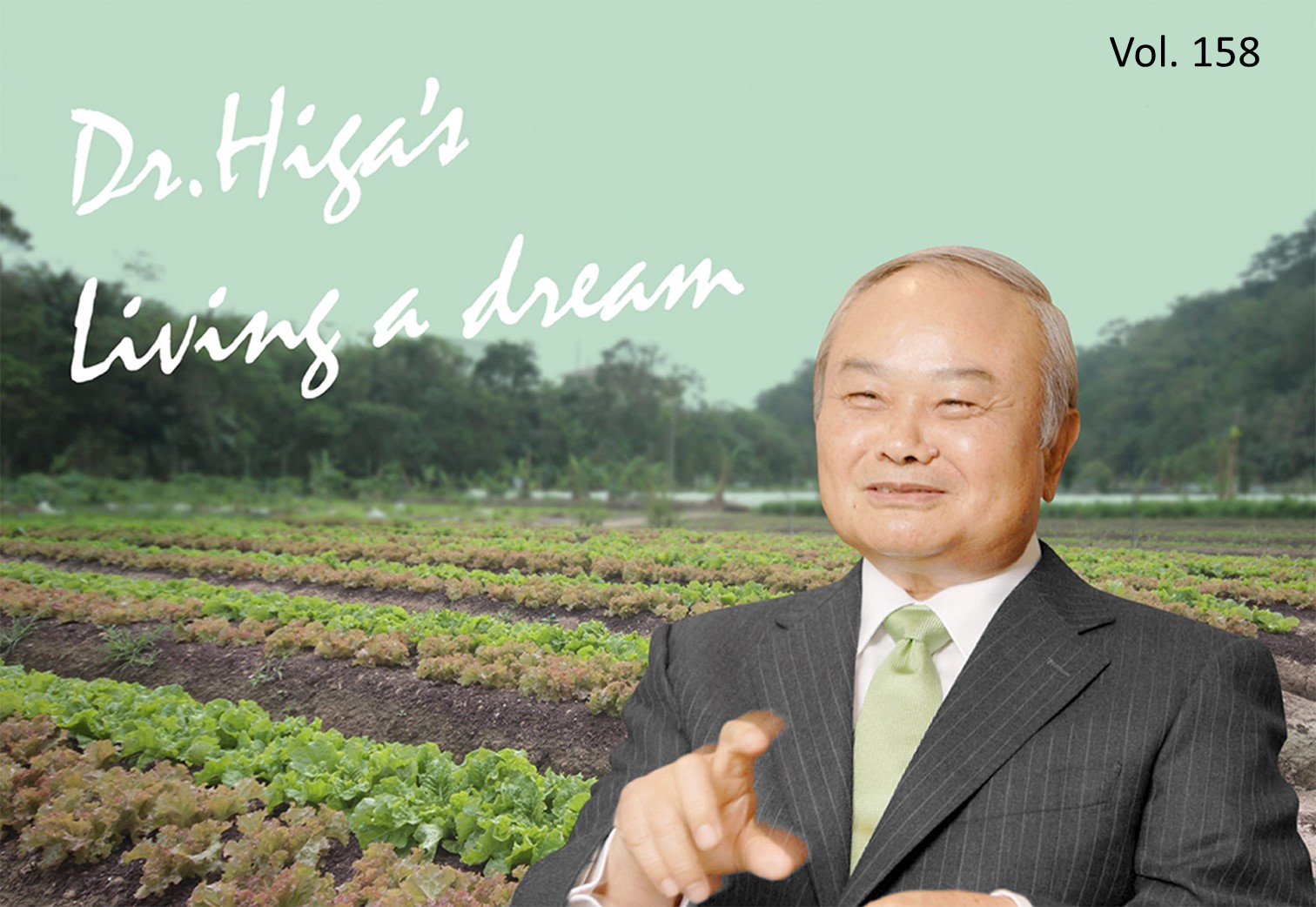

As I wrote in the 149th edition of this series, on April 23, 2020, we took bold steps to raise the Hado value of the EM・X GOLD production line in order to strengthen measures against the novel coronavirus. At the same time, we strengthened the Hado of the eighteen 6,600-volt transformers in the Hotel Costa Vista, etc., greatly raised the level of the EM barrier throughout the Ryukyu Islands, and have continued to disseminate, as needed, information on the results of what is happening in Okinawa.
In the 150th edition of this series in June 2020, we introduced an unimaginable effect, which occurred only about two months after treatment. In a word, the viruses of various plants have disappeared. In addition, natural disasters, including Typhoon No. 10, have been extremely reduced, greenery has become even more lush, and news about flowers has been filling local newspapers every day.
EM Ceramics’ Hado has a virus-suppressing effect, and I have already introduced various examples of its application. One thing that is clear so far is that Hado can be sent in an extended manner over power lines and is shown to be reproducible through O-ring tests and various Hado measurement methods.
As I explained in the 151st edition of this series, the Hado of the EM barrier in Okinawa (Ryukyu Islands) has now reached 3.9 while EMX Ceramics and SPACEMATE are 1.0. There is also a method of using water that SPACEMATE or EMX Ceramics have soaked in, in combination with EM7 or activated EM solution, as a countermeasure against plant pests and viral diseases.
Cucumbers and tomatoes are fine at this level, but potatoes and any tuberous plants must be 2.0 or higher; papaya virus is the strongest and difficult to control unless the Hado of the EM barrier is 3.1 or higher. Viruses have the property of being evolutionarily virulent, so long-term observation is required.
The papaya presented this time had traces of the virus on the top in June 2020, but as of February 2021 these have completely disappeared. Papaya virus is particularly viable in winter, and even healthy strains of the fruit have a slight yellowing at the top, however this year such cases have not occurred anywhere in Okinawa (See Photos 1 and 2).
In the 150th edition of this series in June 2020, we introduced an unimaginable effect, which occurred only about two months after treatment. In a word, the viruses of various plants have disappeared. In addition, natural disasters, including Typhoon No. 10, have been extremely reduced, greenery has become even more lush, and news about flowers has been filling local newspapers every day.
EM Ceramics’ Hado has a virus-suppressing effect, and I have already introduced various examples of its application. One thing that is clear so far is that Hado can be sent in an extended manner over power lines and is shown to be reproducible through O-ring tests and various Hado measurement methods.
As I explained in the 151st edition of this series, the Hado of the EM barrier in Okinawa (Ryukyu Islands) has now reached 3.9 while EMX Ceramics and SPACEMATE are 1.0. There is also a method of using water that SPACEMATE or EMX Ceramics have soaked in, in combination with EM7 or activated EM solution, as a countermeasure against plant pests and viral diseases.
Cucumbers and tomatoes are fine at this level, but potatoes and any tuberous plants must be 2.0 or higher; papaya virus is the strongest and difficult to control unless the Hado of the EM barrier is 3.1 or higher. Viruses have the property of being evolutionarily virulent, so long-term observation is required.
The papaya presented this time had traces of the virus on the top in June 2020, but as of February 2021 these have completely disappeared. Papaya virus is particularly viable in winter, and even healthy strains of the fruit have a slight yellowing at the top, however this year such cases have not occurred anywhere in Okinawa (See Photos 1 and 2).

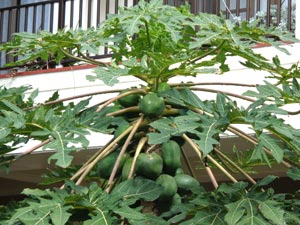
Based on this evidence, the strongest plant virus in Okinawa has disappeared. As I have always said, plants are healthiest when virus-free, and EM has the power to change the agriculture and botanical history of the Ryukyu Islands.
One phenomenon symbolic of this is how well flowers are blooming. If carnations, chrysanthemums and bulbs are also virus-free, they will bloom beautifully like different varieties.
From February our local newspaper, Okinawa Times, has posted reports on flowers every day, but such information has been limited so far.
The Kanhizakura (Prunus campanulata) in photo 3 has 1.5 to 2 times more flowers than usual. Photos 4, 6 and 7 show typical information about Sakura (cherry blossom) published in local newspapers. In February, in addition to Sakura, Ume (Japanese plum) blossoms (photos 5 and 8), Ipe (Pink trumpet tree, Tabebuia impetiginosa) (photo 9), and Cosmos (photo 10), etc. are blooming in ways that have never been seen before.
It is difficult for the general public to understand the effect of the EM barrier, and before long people will forget the less fortunate earlier days and think that Okinawa has been a paradise since ancient times. I would like to document this as a historical record to verify the effects of EM.
One phenomenon symbolic of this is how well flowers are blooming. If carnations, chrysanthemums and bulbs are also virus-free, they will bloom beautifully like different varieties.
From February our local newspaper, Okinawa Times, has posted reports on flowers every day, but such information has been limited so far.
The Kanhizakura (Prunus campanulata) in photo 3 has 1.5 to 2 times more flowers than usual. Photos 4, 6 and 7 show typical information about Sakura (cherry blossom) published in local newspapers. In February, in addition to Sakura, Ume (Japanese plum) blossoms (photos 5 and 8), Ipe (Pink trumpet tree, Tabebuia impetiginosa) (photo 9), and Cosmos (photo 10), etc. are blooming in ways that have never been seen before.
It is difficult for the general public to understand the effect of the EM barrier, and before long people will forget the less fortunate earlier days and think that Okinawa has been a paradise since ancient times. I would like to document this as a historical record to verify the effects of EM.
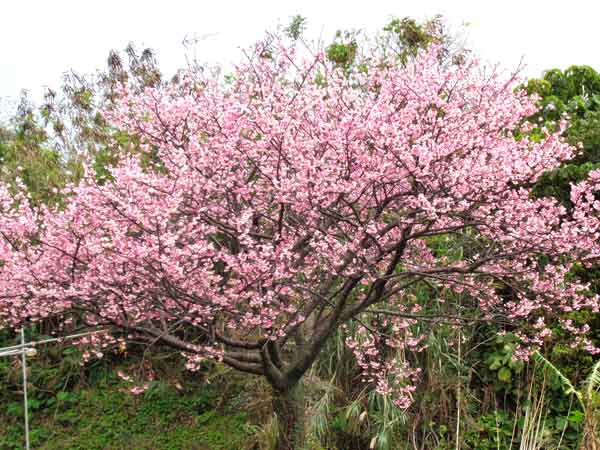
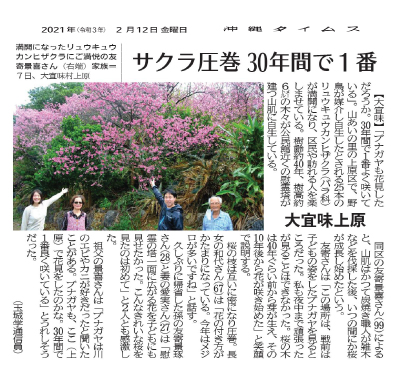
The most beautiful in 30 years
2/12/2021 (provided by Okinawa Times)
Spectacular Sakura blossoms The most beautiful in 30 years
Ogimi Village, Uehara
[Ogimi] “I wonder if the BUNAGAYA saw the cherry blossoms? These are the most beautiful blossoms in the last thirty years.” In Uehara-ku, a mountain village, twenty-five Ryukyu Kanhizakura trees (Prunus campanulata, Rosaceae), the seeds of which are believed to have been brought in by wild birds, are now in full bloom and villagers and visitors alike are enjoying the sight. The trees, about forty years old and six meters around, grow on the hillside where a memorial tower stands near the public hall.
[Note: The “BUNAGAYA” are mysterious beings that love peace and Mother Nature, skillfully utilizing the blessings of the forest and river, and sometimes even making their presence known to us.]
According to Mr. Tomoyose (99) from Uehara-ku, the cherry trees began to grow on the mountain surface, before they even noticed, after the charcoal makers cut down various other trees.
Mr. Tomoyose happily elaborated: “Before the war, this place was where we could see BUNAGAYA in the shape of a child. I stayed up until midnight to see it, but I couldn’t. The cherry tree buds sprouted about forty years ago, and the flowers began to bloom ten years later.”
The branches of the cherry blossoms are densely packed next to each other and are incredible.
His eldest daughter, Kazuyo (67) notes how, “This year the blossoms cluster together and we have seen many warbling white-eye birds.”
His grandson (28) and his wife (27), who returned home after a long absence, said, “We wanted to show our children the cherry blossoms that spread all over the memorial tower.” They both were overwhelmed and said they’d never seen such beautiful cherry blossoms.
His grandfather said happily, “I have heard that BUNAGAYA liked river shrimps and crabs. I wonder if BUNAGAYA also saw cherry blossoms here in Uehara. This year is the best in thirty years.” (reported by Mr. Manabu Tamashiro)
Photo caption: Mr. (Keiki) Tomoyose’s family (far right), pleased with the Ryukyu cherry blossoms in full bloom (on the 7th in Uehara, Ogimi Village.)
Ogimi Village, Uehara
[Ogimi] “I wonder if the BUNAGAYA saw the cherry blossoms? These are the most beautiful blossoms in the last thirty years.” In Uehara-ku, a mountain village, twenty-five Ryukyu Kanhizakura trees (Prunus campanulata, Rosaceae), the seeds of which are believed to have been brought in by wild birds, are now in full bloom and villagers and visitors alike are enjoying the sight. The trees, about forty years old and six meters around, grow on the hillside where a memorial tower stands near the public hall.
[Note: The “BUNAGAYA” are mysterious beings that love peace and Mother Nature, skillfully utilizing the blessings of the forest and river, and sometimes even making their presence known to us.]
According to Mr. Tomoyose (99) from Uehara-ku, the cherry trees began to grow on the mountain surface, before they even noticed, after the charcoal makers cut down various other trees.
Mr. Tomoyose happily elaborated: “Before the war, this place was where we could see BUNAGAYA in the shape of a child. I stayed up until midnight to see it, but I couldn’t. The cherry tree buds sprouted about forty years ago, and the flowers began to bloom ten years later.”
The branches of the cherry blossoms are densely packed next to each other and are incredible.
His eldest daughter, Kazuyo (67) notes how, “This year the blossoms cluster together and we have seen many warbling white-eye birds.”
His grandson (28) and his wife (27), who returned home after a long absence, said, “We wanted to show our children the cherry blossoms that spread all over the memorial tower.” They both were overwhelmed and said they’d never seen such beautiful cherry blossoms.
His grandfather said happily, “I have heard that BUNAGAYA liked river shrimps and crabs. I wonder if BUNAGAYA also saw cherry blossoms here in Uehara. This year is the best in thirty years.” (reported by Mr. Manabu Tamashiro)
Photo caption: Mr. (Keiki) Tomoyose’s family (far right), pleased with the Ryukyu cherry blossoms in full bloom (on the 7th in Uehara, Ogimi Village.)
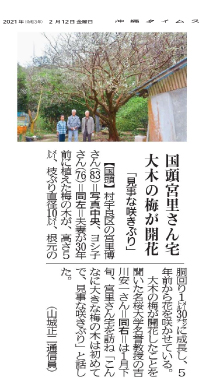
2/5/2021 (provided by Okinawa Times)
The Miyazato’s house, a large Ume (Japanese plum) tree with “Incredibly beautiful blossoms”
Mr. Hiroshi Miyazato in Ura-ku, Kunigami Village (83), in the center of the photo, and his wife, Yoshiko (76), on the left, planted a Ume tree thirty years ago and it has grown to a height of five meters, with a branch diameter of ten meters, and the circumference of the root of the tree is now 1.3 meters. It has been in bloom every year for the last five years.
Professor Yasuichi Furukawa (on the right), an emeritus professor at Meio University, visited the Miyazato house in late January when he heard that the Ume blossoms of a large tree had bloomed. “It is the first time for me to see such a big Ume tree in bloom,” Prof. Furukawa commented. “It is amazing in full bloom.” (Reported by Mr. Yamashiro)
Mr. Hiroshi Miyazato in Ura-ku, Kunigami Village (83), in the center of the photo, and his wife, Yoshiko (76), on the left, planted a Ume tree thirty years ago and it has grown to a height of five meters, with a branch diameter of ten meters, and the circumference of the root of the tree is now 1.3 meters. It has been in bloom every year for the last five years.
Professor Yasuichi Furukawa (on the right), an emeritus professor at Meio University, visited the Miyazato house in late January when he heard that the Ume blossoms of a large tree had bloomed. “It is the first time for me to see such a big Ume tree in bloom,” Prof. Furukawa commented. “It is amazing in full bloom.” (Reported by Mr. Yamashiro)
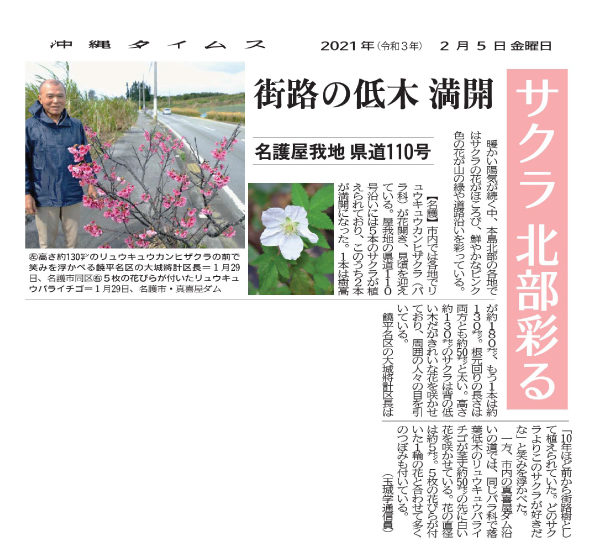
2/5/2021 (provided by Okinawa Times)
Sakura (cherry blossom) are in full bloom, coloring the northern part of the main island of Okinawa
Small roadside Sakura trees are in full bloom
Yagaji Island, Nago City, Prefectural Road 110
In the warm weather, Sakura blossoms are beginning to open in various areas of the northern part of the main island, and vibrant bright pink flowers color the greenery of the mountains and along the roads.
Ryukyu Kanhizakura (Prunus campanulata, Rosaceae) is in full bloom in various parts of Nago city and are at their best. Five Ryukyu Kanhizakura trees have been planted along Prefectural Road 110 in Yagiji, and two of them are in full bloom. One is about 180cm tall and the other is about 130cm. Both trees are about 50cm in circumference at the root. The Sakura tree that is about 130cm is short, but it has very beautiful flowers that catch the eyes of all those who behold it.
The head of Yohena-ku, Mr. Shokei Oshiro said, happily, that “These trees were planted about ten years ago. I like their Sakura blossoms better than those of any other Sakura trees.”
On the other hand, on the road along the Makiya dam in the city, a Ryukyu rose strawberry, a deciduous shrub of the same variety as Rosaceae, has white flowers at the tip of about 50cm up its stem. The diameter of the flowers is about 5cm. Along with a single flower with five petals, it also has many buds. (reported by Mr. Manabu Tamaki)
Small roadside Sakura trees are in full bloom
Yagaji Island, Nago City, Prefectural Road 110
In the warm weather, Sakura blossoms are beginning to open in various areas of the northern part of the main island, and vibrant bright pink flowers color the greenery of the mountains and along the roads.
Ryukyu Kanhizakura (Prunus campanulata, Rosaceae) is in full bloom in various parts of Nago city and are at their best. Five Ryukyu Kanhizakura trees have been planted along Prefectural Road 110 in Yagiji, and two of them are in full bloom. One is about 180cm tall and the other is about 130cm. Both trees are about 50cm in circumference at the root. The Sakura tree that is about 130cm is short, but it has very beautiful flowers that catch the eyes of all those who behold it.
The head of Yohena-ku, Mr. Shokei Oshiro said, happily, that “These trees were planted about ten years ago. I like their Sakura blossoms better than those of any other Sakura trees.”
On the other hand, on the road along the Makiya dam in the city, a Ryukyu rose strawberry, a deciduous shrub of the same variety as Rosaceae, has white flowers at the tip of about 50cm up its stem. The diameter of the flowers is about 5cm. Along with a single flower with five petals, it also has many buds. (reported by Mr. Manabu Tamaki)
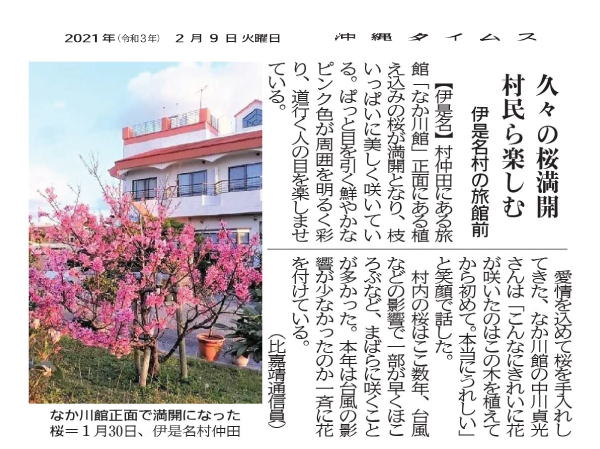
1/24/2021 (provided by Okinawa Times)
Sakura (cherry blossoms) in full bloom after a long time
Villagers Enjoy Them
In front of an inn at Izena village
The Sakura (cherry blossom) tree, in shrubbery at the front of the Nakagawa Inn at Nakada, Izena village, is now in full bloom, with every branch blooming beautifully. The vibrant bright pink adds brilliant color to the surroundings and is pleasing to the eyes of passers-by.
Mr. Sadamitsu Nakagawa of Nakagawa Inn, who has been lovingly caring for the Sakura commented that, “It is the first time since I planted this tree that the flowers have bloomed so beautifully. I couldn’t be happier.”
In recent years, some of the Sakura in the village have been blooming too early because of typhoons and other factors. However, the flowers are blooming all at once this year, probably because typhoons had little influence.
(Reported by Mr. Yasushi Higa)
Photo caption: The cherry tree in the front of the Nakagawa Inn in Nakada, Izena village is now in full bloom.
Villagers Enjoy Them
In front of an inn at Izena village
The Sakura (cherry blossom) tree, in shrubbery at the front of the Nakagawa Inn at Nakada, Izena village, is now in full bloom, with every branch blooming beautifully. The vibrant bright pink adds brilliant color to the surroundings and is pleasing to the eyes of passers-by.
Mr. Sadamitsu Nakagawa of Nakagawa Inn, who has been lovingly caring for the Sakura commented that, “It is the first time since I planted this tree that the flowers have bloomed so beautifully. I couldn’t be happier.”
In recent years, some of the Sakura in the village have been blooming too early because of typhoons and other factors. However, the flowers are blooming all at once this year, probably because typhoons had little influence.
(Reported by Mr. Yasushi Higa)
Photo caption: The cherry tree in the front of the Nakagawa Inn in Nakada, Izena village is now in full bloom.

1/24/2021 (provided by Okinawa Times)
Ume (Japanese plum) blossoms are in full bloom
Cherry flowers (blossoms) are about to bloom
Ume blossoms are in full bloom in Izumi, Motobu-cho, Okinawa Prefecture. Several white flowering Ume trees are in bloom along the road from the village to Mount Yaedake and the road from Izumi Elementary/Junior High School to Begonia Garden.
In Okinawa, Ume and Kanhizakura (Prunus campanulata) flower at almost the same time, and there was a half-bloomed Kanhizakura tree along the road to Mount Yaedake. “Ume and Kanhizakura blossom at the same time, don’t they?” The sweet scent of Ume blossoms was in the air, and one of the drivers who stopped his car was holding his cell phone toward the flowers to take a picture. (Reported by Mr. Manabu Tamaki)
Ume blossoms with a delicate fragrance
Izumi, Motobu-cho on the afternoon of the 25th (photo by Mr. Satoshi Kuniyoshi)
Cherry flowers (blossoms) are about to bloom
Ume blossoms are in full bloom in Izumi, Motobu-cho, Okinawa Prefecture. Several white flowering Ume trees are in bloom along the road from the village to Mount Yaedake and the road from Izumi Elementary/Junior High School to Begonia Garden.
In Okinawa, Ume and Kanhizakura (Prunus campanulata) flower at almost the same time, and there was a half-bloomed Kanhizakura tree along the road to Mount Yaedake. “Ume and Kanhizakura blossom at the same time, don’t they?” The sweet scent of Ume blossoms was in the air, and one of the drivers who stopped his car was holding his cell phone toward the flowers to take a picture. (Reported by Mr. Manabu Tamaki)
Ume blossoms with a delicate fragrance
Izumi, Motobu-cho on the afternoon of the 25th (photo by Mr. Satoshi Kuniyoshi)
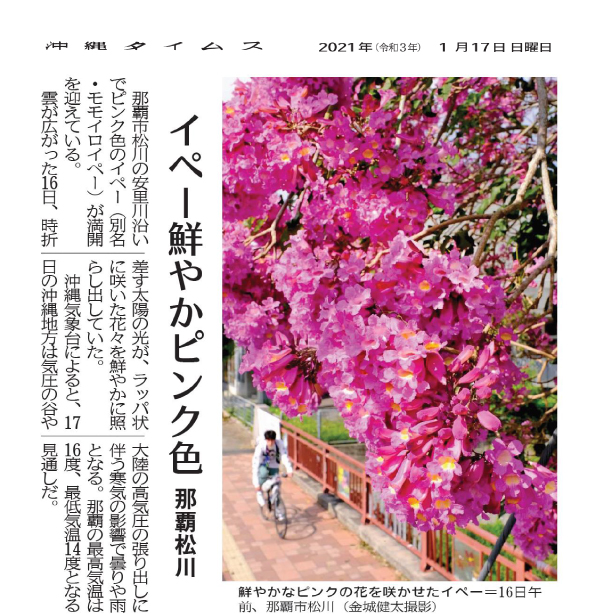
1/17/2021 (provided by Okinawa Times)
Ipe (Pink trumpet tree, Tabebuia impetiginosa) Bright pink flowers are blooming
Along the Asato River in Matsukawa, Naha City, the pink Ipe (also known as Momoiro Ipe, pink trumpet tree) is in full bloom. On the 16th, a cloudy day, occasional sunlight shone brightly on the trumpet-shaped flowers. According to the Okinawa Meteorological Observatory, the Okinawa region on the 17th will be cloudy and rainy due to the effects of the trough and the cold air caused by a high-pressure system on the continent. The high temperature in Naha is expected to be 16 ℃, with a low of 14 ℃.
Photo caption:
Bright pink Ipe flowers are blooming
Matsugawa, Naha City on the morning of the 16th (photo by Mr. Kenta Kinjo)
Along the Asato River in Matsukawa, Naha City, the pink Ipe (also known as Momoiro Ipe, pink trumpet tree) is in full bloom. On the 16th, a cloudy day, occasional sunlight shone brightly on the trumpet-shaped flowers. According to the Okinawa Meteorological Observatory, the Okinawa region on the 17th will be cloudy and rainy due to the effects of the trough and the cold air caused by a high-pressure system on the continent. The high temperature in Naha is expected to be 16 ℃, with a low of 14 ℃.
Photo caption:
Bright pink Ipe flowers are blooming
Matsugawa, Naha City on the morning of the 16th (photo by Mr. Kenta Kinjo)
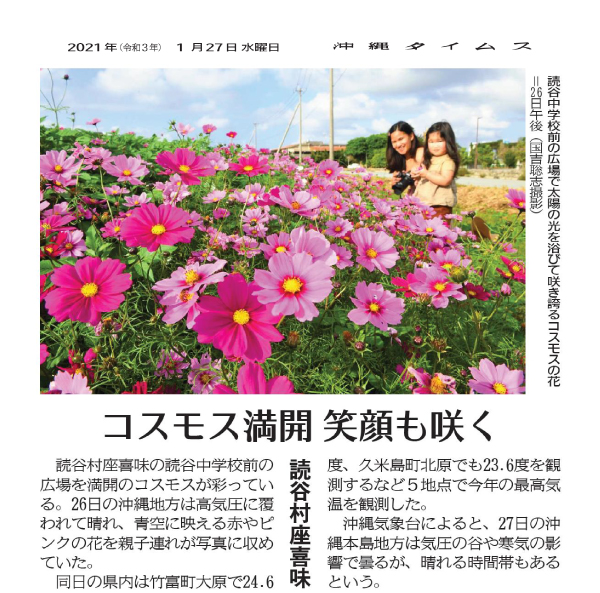
1/27/2021 (provided by Okinawa Times)
Cosmos in full bloom
Everyone’s smiles are blooming, too.
Cosmos in full bloom decorate the planted green space in the plaza in front of Yomitan Junior High School in Zakimi, Yomitan Village. The Okinawa region on the 26th was covered with a high-pressure system and it was sunny, and parents and children enjoyed taking pictures of the red and pink Cosmos that were shining under the blue sky. On the same day, the highest temperatures of this year were observed at five places including 24.6℃ in Ohara, Taketomi-cho and 23.6℃ in Kitahara, Kumejima-cho.
According to the Okinawa Meteorological Observatory, the main island of Okinawa on the 27th will be cloudy due to the effects of troughs and cold air, but there will be times when it will be fine.
(Explanation of the drawing) Cosmos flowers in full bloom in the plaza in front of Yomitan Junior High School
On the 26th afternoon (photo by Mr. Satoshi Kuniyoshi)
Everyone’s smiles are blooming, too.
Cosmos in full bloom decorate the planted green space in the plaza in front of Yomitan Junior High School in Zakimi, Yomitan Village. The Okinawa region on the 26th was covered with a high-pressure system and it was sunny, and parents and children enjoyed taking pictures of the red and pink Cosmos that were shining under the blue sky. On the same day, the highest temperatures of this year were observed at five places including 24.6℃ in Ohara, Taketomi-cho and 23.6℃ in Kitahara, Kumejima-cho.
According to the Okinawa Meteorological Observatory, the main island of Okinawa on the 27th will be cloudy due to the effects of troughs and cold air, but there will be times when it will be fine.
(Explanation of the drawing) Cosmos flowers in full bloom in the plaza in front of Yomitan Junior High School
On the 26th afternoon (photo by Mr. Satoshi Kuniyoshi)
※ This column describes the possibilities of EM technology during the state of emergency from the perspective of Professor Higa as an academic.
(March 15, 2021)
Editor’s Picks
-

#196 The Steadily Evolving EM Nature Farming Method at the Blue Sky Palace - Part 6 -

#195 The Steadily Evolving EM Nature Farming Method at the Blue Sky Palace - Part 5 -

#191 Steadily Evolving EM Nature Farming Method at the Blue Sky Palace -

#190 Quantum Mechanical Effects of EM Gravitron Charcoal
- 2025
- Sep:#209 The Widespread Use of EM in Ecuador
- Sep:#208 The Widespread Use of EM in Chile
- Jul:#207 Peru, where EM has taken root throughout the country
- May:#206 EM Application Technology in Paraguay Begins to Evolve into Advanced Circular Agriculture
- May:#205 Practical Application of Soil Disinfectant-Free Cultivation Using EM Technology
- Apr:#204 How EM Use Has Spread Throughout the Philippines
- Mar:#203 How to Use EM to Fundamentally Solve the Problem of Agricultural Residue Burning
- Feb:#202 The Spread of EM technology in Germany
- Jan:#201 The 2nd Ichiro Masaki Memorial Universal Village EM International Conference
- Jan:#200 Cleanup of the Ala Wai Canal in Hawaii, where social bonds are strengthened using EM
- 2024
- Nov:#199 EM trials in India with bananas, tomatoes, and pomegranates
- Oct:#198 The Steadily Evolving EM Nature Farming Method at the Blue Sky Palace - Part 8
- Sep:#197 The Steadily Evolving EM Nature Farming Method at the Blue Sky Palace - Part 7
- Aug:#196 The Steadily Evolving EM Nature Farming Method at the Blue Sky Palace - Part 6
- Jul:#195 The Steadily Evolving EM Nature Farming Method at the Blue Sky Palace - Part 5
- Jun:#194 Steadily Evolving EM Nature Farming Method at the Blue Sky Palace - Part 4
- May:#193 Steadily Evolving EM Nature Farming Method at the Blue Sky Palace - Part 3
- May:#192 Steadily Evolving EM Nature Farming Method at the Blue Sky Palace - Part 2
- Apr:#191 Steadily Evolving EM Nature Farming Method at the Blue Sky Palace
- Mar:#190 Quantum Mechanical Effects of EM Gravitron Charcoal
- Mar:#189 The barrier space in Okinawa (Ryukyu Islands) has risen to another dimension
- Jan:#188 Sixty Days after Typhoon No.6
- 2023
- Oct:#187 Supermassive Typhoon No.6 and Subsequent Typhoon No. 11
- Sep:#186 Massive Typhoon No.6 that swallowed the Ryukyu Islands Graviton barrier
- Sep:#185 August 8th is World “EM Mudball Day”
- Aug:#184 A disease-free life depends on the health of the intestinal microbiome.
- Jul:#183 Trial and Error at the Blue-Sky Palace, Part 3
- Jun:#182 Trial and Error at the Blue-Sky Palace, Part 2
- Apr:#181 Trial and Error at the Blue-Sky Palace
- Mar:#180 Ala Wai Canal Cleanup Project in Waikiki, Hawaii
- Feb:#179 High-Yield, High-Quality Rice Production Using EM
- Feb:#178 The Progress the "Soil Preparation Workshop" of the Oishi 3-chan Club (Part 2)
- Jan:#177 Organic Farming Instructional Manual Using EM
- 2022
- Nov:#176 The Typhoon Situation in Okinawa in 2022
- Sep:#175 Third-Party Verification of the Graviton barrier in Okinawa Part-2
- Sep:#174 Third-Party Verification of the Graviton barrier in Okinawa
- Aug:#173 Ecosystem Changes Observed in Okinawa in 2021 Part-5
- Jun:#172 Ecosystem Changes Observed in Okinawa in 2021 Part-4
- May:#171 Ecosystem Changes Observed in Okinawa in 2021 Part-3
- Apr:#170 Ecosystem Changes Observed in Okinawa in 2021 Part-2
- Mar:#169 Koizumi Farm in Kamakura Continues to Evolve
- Feb:#168 Ecosystem Changes Observed in Okinawa in 2021 Part-1
- 2021
- Dec:#167 Enjoying EM Technology While Enriching the Local Ecosystem
- Nov:#166 A Case Study of the Use of EM in a Next Generation Free School in Tune with the Cycles of Nature
- Oct:#165 Typhoon conditions and flowers in Okinawa from August to October
- Sep:#164 Re-learning the origins of river purification using EM Cleaning up the Dairyuji River in Senami (Murakami City, Niigata Prefecture)
- Aug:#163 Measures Against Natural Disasters and Re-learning the Starting Point of EM
- Jul:#162 Summary of FFC (Foods for Children) Okinawa Forum 2021
- Jun:#161 Restoring the Vigor of an Old Tree and Purifying the Environment with EM Technology That Even an Amateur Can Do
- May:#160 The Public is Beginning to Recognize the Use of EM Smokeless Carbonizers
- Apr:#159 EM Hado (EM Graviton) that exerts quantum superposition effect over time
- Mar:#158 Virus-free Okinawan Plants Through Use of an EM Graviton Barrier
- Jan:#157 Enjoyable Farming for Self-Sufficiency that Even Amateurs Can Do
- 2020
- Dec:#156 EM quantum energy effect occurring in Okinawa
- Nov:#155 Implementing EM graviton farming as a flood countermeasure for apple orchards
- Oct:#154 The Latest Book on the Practical Uses of EM "You Are the One Who Draws Out the Power of Microorganisms," by Chizuko Nomoto
- Sep:#153 Application of EM technology to long periods of rain, lack of sunshine, storms, heavy rains, etc.
- Aug:#152 EM application in Kitanakagusuku village plant waste recycling yard
- Jul:#151 Natural Disaster Countermeasures Using EM Technology: Part 2
- Jul:#150 Natural Disaster Countermeasures Using EM Technology
- May:#149 How to make your home and workplace an energy spot by living a complete EM lifestyle: creating the ultimate source of health and environmental purification
- Apr:#148 EM, Viruses and the Pandemic
- Apr:#147 New agriculture applying quantum mechanics Part 2
- Apr:#146 New agriculture applying quantum mechanics
- Apr:#145 Wonderful EM Miracle
- 2019
- Nov:#144 The movie “Revival II” and the reality of Fukushima
- Oct:#143 Boundary dome and foliar spraying of EM・X GOLD and EM 3
- Oct:#142 Kirakira (Sparkling) Summer Vegetable Festa in 2019
- Aug:#141 Excessive salt inevitably causes salt damage
- Jul:#140 Diverse applications of charcoal Part 3
- Jun:#139 Diverse applications of charcoal Part 2
- Jun:#138 Diverse applications of charcoal
- Jun:#137 Purification power of salt
- May:#136 The degree of soil contamination is a reflection of the microflora
- May:#135 Definitive use of EM barriers to deal with typhoons
- May:#134 Implementing authentic Nature Farming
- May:#133 How to enhance healthy Hado (wave energy) by EM
- May:#132 Eating Dirt (Soil)
- May:#131 Hado (Wave energy) involved in health
- May:#130 Reaffirming EM technology to realize the essence of agriculture
- May:#129 The 2nd EM Producer Networking Meeting
- Apr:#128 Understanding the application of seawater and salt in crop cultivation
- Apr:#127 Prevention of Disasters by EM Technology
- Mar:#126 Quantum overlay effective utilization of EM
- Jan:#125 EM Disaster Recovery Support Projects in 2017
- 2018
- 2017
- Aug:#121 Escape from conventional agricultural traps
- Jul:#120 Limitation and important caveats regarding utilization of salt
- Jun:#119 EM Technology to Break Through the Limits of Pesticide-Free Strawberries
- May:#118 Application of barriers using EM rectification force
- Apr:#117 The 1st EM Produce Growers' Networking Conference
- Mar:#116 Sumizo kun: The Ultimate Versatile Carbonization Equipment
- Feb:#115 How to make and use simple carbonized and rectified ash
- Jan:#114 Achievements of 2016
- 2016
- Dec:#113 Definitive Measures Against Typhoons
- Nov:#112 International Conference on Universal Village
- Oct:#111 90% of Your Body is Microbes
- Sep:#110 Disaster Countermeasures Using EM
- Aug:#109: Changes in the Natural Environment by EM Barrier Domes in Okinawa
- Jul:#108: Multi-purpose Utilization of Activated EM with Seawater and Salt
- Jun:#107: Marine Day, when EM Mudballs and Activated EM are Applied Throughout Japan
- May:#106: The Function of EM and Gravitational Waves–Part 3
- Apr:#105: The Function of EM and Gravitational Waves–Part 2
- Feb:#104: The Function of EM and Gravitational Waves
- Feb:#103: The Importance of Phototrophic Bacteria in EM
- 2015
- Dec:#102: Results of Environmental Forum "Utsukushima EM Paradise" 2015
- Nov:#101: Environmental Forum "Utsukushima EM Paradise" 2015
- Oct:#100: A New Phase of Limit Breakthrough Using EM
- Sep:#99: A New Phase of Limit Breakthrough through EM
- Aug:#98: The Tokyo Bay Area Began Creating a Truly Livable Hometown
- Jul:#97: Rectifying Effects of EM
- Jun:#96: Lake Suwa Sousei lecture
- May:#95: In Order to Further Ensure Limit Breakthrough
- Apr:#94: Theatrical Release of the Documentary Film SOSEI-Revival to Enlighten People on the New Possibilities of Microorganisms
- Mar:#93: What Underlies Limit Breakthrough (Part 2)
- Feb:#92: EM Functions to Break Through Limits
- Jan:#91: At the Start of 2015
- 2014
- Dec:#90: Looking Back at 2014
- Nov:#89: Shikoku EM FESTA 2014, Virtuous Circle Conference in Matsuyama, Ehime Prefecture
- Oct:#88: Using EM to Deal with Weather Disasters (Part 2)
- Sep:#87: Current Status of Radioactivity Measures Using EM in Fukushima
- Aug:#86: APNAN (Asia Pacific Natural Agriculture Network) 25th Anniversary Conference in 2014
- Jul:#85: Using EM to Deal with Weather Disasters
- Jun:#84: Substantial Improvement of Soil
- May:#83: The Energy Rectification Force of EM
- Apr:#82: The Annual 18th EM Technology Exchange Meeting and Tohoku Conference in Shichigahama
- Mar:#81: Salmon going upstream in Kitaura (Kasumigaura)
- Feb:#80: The Microbiome Again
- Jan:#79: Inauguration of the Federation of Diet Members Who Use and Apply Effective Microorganisms
- 2013
- Dec:#78: Receiving an Honorary Doctoral Degree from Rajamangala University of Technology in Thailand
- Nov:#77: The Use of EM in School Education in Bhutan
- Oct:#76: Well of Bonding
- Sep:#75: The Background to EM Not Being Employed by Public Institutions to Deal with Radiation
- Aug:#74: Dealing with Disaster: Using EM in Crisis Management
- Jul:#73: EM Events on Ocean Day
- Jun:#72: Using EM to Deal With Heat Stroke and Summer Heat Fatigue
- May:#71: An EM Model Town in Malaysia
- Apr:#70: Steps the Japanese Government is Taking to Deal with Radiation: Are They Really Safe?
- Mar:#69: EM Group Disaster Reconstruction Aid Project in Fukushima
- Feb:#68: EM and Microbiomes (Microbial Flora)
- Jan:#67: A Necessary Evil is Still Evil
- 2012
- Dec:#66: The 17th National EM Technology Exchange Conference / Hokkaido Conference in Sapporo
- Nov:#65: EM Forum 2012 in Okinawa and the Environmental Forum in Fukushima
- Oct:#64: 2012 EM Forum
- Sep:#63: A New Earth Saving Revolution
- Aug:#62: The Asahi Newspaper’s Misguided Reports About EM
- Jul:#61: Using EM in Radioactive Contamination Measures in Fukushima Prefecture
- Jun:#60: The Effects of Using EM to Inhibit the Absorption of Radioactivity as Confirmed in Fukushima
- May:#59: Recovery Support for the Great East Japan Earthquake
- Apr:#58: The Royal Kingdom of Thailand, in which EM Functions as a Set Government Policy
- Mar:#57: Report on the Measures Taken by Kingdom of Thailand Using EM to Deal with Polluted Water
- Feb:#56 EM™ as Part of National Policy in Thailand to Deal with Sanitation Issues Resulting from the Flood of 2011
- Jan:#55 The Law of Syntropy (Revitalization)
- 2011
- Dec:#54 EM Forum 2011
- Nov:#53 Shikoku EM Festa 2011- Zenjunkan no Wa (Virtuous Circle) Tokushima Conference in Naruto -
- Oct:#52 The Mystery of Interim Safety Values for Radioactive Material
- Sep:#51 Successful Radiation Countermeasures Using EM
- Aug:#50 Events on Sea Day in which EM Mud Balls are Thrown into the Water and Activated EM is Applied.
- May:#47 Dealing with the Damage Caused by the Eastern Japan Earthquake
- Apr:#46 Eastern Japan Earthquake
- Mar:#45 The 16th National EM Technology Hokuriku Conference in Fukui
- Feb:#44 More Thoughts on Avian Influenza and Foot-and-Mouth Disease
- Jan:#43 Happy New Year!
- 2010
- Dec:#42 Shikoku EM FESTA 2010・Zenjunkan no wa (Virtuous Circle) Fellowship Conference in Tobe, Ehime Prefecture
- Nov:#41 EM Forum 2010
- Oct:#40: My Thanks to the EM™ Volunteers Who Helped in the Fight Against Foot-and-Mouth Disease in Miyazaki Prefecture
- Sep:#39 International EM Mud Ball Day
- Jul:#37 Poland EM Forum 2010
- Jun:#36 EM Countermeasures Against Foot-and-Mouth Disease
- May:#35 Abnormal Weather
- Apr:#34 EM Activities in Thailand: Finding Solutions to the Challenges Facing the Nation
- Mar:#33 New Developments in the Evolution of EMTM in Thailand
- Feb:#32 Results Starting to Be Seen at the Mikasa Project
- Jan:#31 Towards an EM-Use Society
- 2009
- Dec:#30 EM Summit
- Nov:#29 The System in Penang State in Malaysia that Made the World EMTM Mudball Day a Success
- Oct:#28 The "World EM Mudball Day" in Malaysia
- Sep:#27 Validating EMTM Medicine: Case Study Reports from EM Users 2009. (Part 3)
- Sep:#26 Validating EMTM Medicine: Case Study Reports from EMTM Users 2009. (Part 2)
- Jul:#25 Validating EMTM Medicine: Case Study Reports from EMTM Users 2009. (Part 1)
- Jun:#24 Activities to Disseminate EM-Focused Nature Farming in China
- May:#23 Use of EMTM in Response to Swine Flu
- Apr:#22 Using EM to Solve Public Administrative Costs
- Mar:#21 Reaffirming the Versatility of EM
- Jan:#20 The Beginning of a New Era
- 2008
